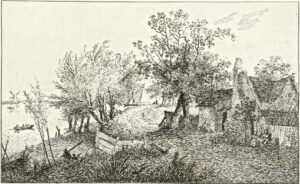
Hello friends. I know you haven’t heard from me for a while, but I haven’t had anything very interesting to share, except some photos on my Instagram. If you’re interested in those you can see them at https://www.instagram.com/historygeek1805/
I’m here in Portsmouth watching the shipping go by in the Solent and not doing enough work. I saw an aircraft carrier sail majestically by the other day—probably the only time in my life I will see an aircraft carrier from my window! And there are massive ferries and container ships and pretty little sailboats…
I was thinking, as I was gazing at the sea, about how much this world has changed since the time the characters from my books inhabited it. I can imagine it (I hope I can; I’m a novelist—it’s supposed to be what I do), and there are some books of remarkable prints by John Thomas Smith, Walter Thornbury, and Alan Stapleton, of London and its environs before they were overrun with people and office blocks. But what would I give to be able to pop through a portal or strap myself into a pod and actually go to that time and see it for myself? To come face to face with Admiral Lord Nelson, Sir John Moore, Mary Wollstonecraft, Angelica Kauffman, or Sir Joshua Reynolds. Or Wellington. Or Napoleon, if your tastes run that way.
I suppose this is why time-travel fantasy is so popular with a particular demographic of people: that desire to really experience the past. A visitor from 1797 coming in the other direction would probably be amazed and horrified in equal measure: where there were once tiny bucolic cottages, there’s now Victoria Station. We’d have such an advantage; we know where we’re headed. As I sit here at my laptop, I have no idea what there was in this part of Portsmouth in 1800. Maybe nothing. (Well, there’s Spithead, but that’s out in the middle of the water.)

Lovely to visit, wouldn’t want to live there…or rather, then. A great deal of how people lived in our past would probably horrify us, too. Think of it; in the First World we have clean water that comes out of a tap when we want it, and boilers that heat it for us. It’s even drinkable, if a bit odd tasting in some locations, but if that bothers you, you can pop over to the supermarket and buy a big bottle of spring water. Then, as you drink it, read about the cholera epidemics in London in the 19th century. People were essentially drinking, cooking, and washing in sewage. They didn’t have a choice.
And we have so many other things that would be challenging to be suddenly deprived of. Sanitation is only the beginning. Bathroom tissue. Electricity. Central heating. Modern medicine (and health insurance). Rapid transit. Fitted kitchens with all manner of appliances. Refrigeration.
As a hobby, I do weekend reenactments of 18th century military encampments. Participants can choose how authentic they want their weekend to be… but even if you’re going the brush-hut route, we still have sources of potable water, ground coffee, teabags, battery-powered light sources, mosquito repellent, sunblock lotion, and portable toilets with tissue rolls and hand sanitiser. Or, if we’re really lucky, ‘flushies’.
Yet the people who actually lived through that period in our history not only survived, it was their achievements which made possible the world we live in now. As sea levels rise and extreme weather affects more and more parts of the world, I can’t help but think that we need to be a little more careful with our inheritance, and much more appreciative of the people who left it to us.



I want to share with you some links that relate to these thoughts. If you’d like to explore further, there are some posts from the Gentle Author’s Spitalfields Life blog (if you’ve never explored Spitalfields Life, there’s so much amazing stuff there to lose yourself in!) The three etchings above are all by John Thomas Smith, and are from the Gentle Author’s blog. Because something went wrong with the captioning, I’ll just tell you that they’re all from the 1780s and 1790s.
There’s also a page from the Old Operating Theatre Museum of St Thomas’s Hospital’s website, which is a very valuable source of information if you’re interested in the history of medicine. If you choose to explore them, I hope you appreciate them as much as I do. I am grateful to the people who took the time to create these pages.
https://spitalfieldslife.com/2020/09/26/john-thomas-smiths-rural-cottages-x-2/
https://spitalfieldslife.com/2022/04/27/john-thomas-smiths-antiquities-of-old-london/
https://spitalfieldslife.com/2024/10/15/vanishing-london-i/
https://spitalfieldslife.com/2024/10/10/a-ramble-through-long-forgotten-london-i/
https://spitalfieldslife.com/2024/10/26/in-search-of-the-alleys-of-old-london-i/
https://oldoperatingtheatre.com/education-cholera/
Cheers for now…
Jennifer